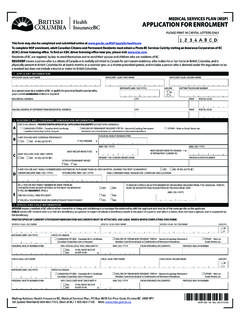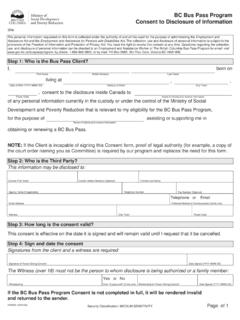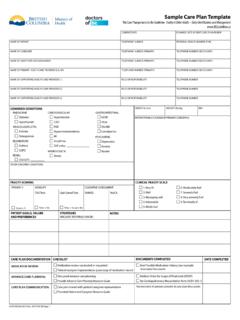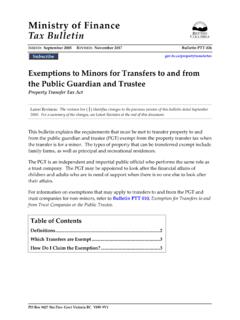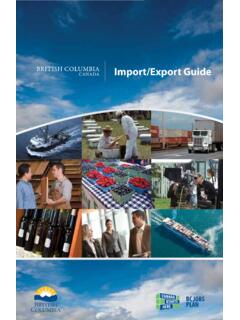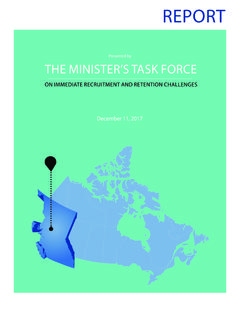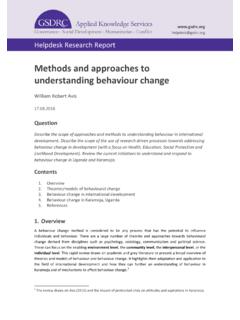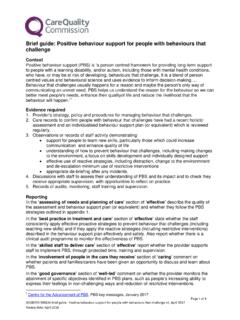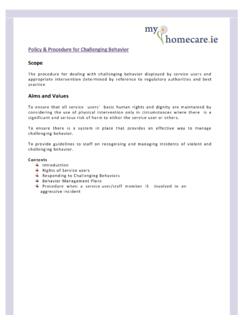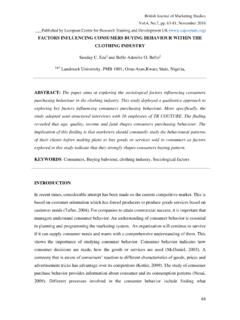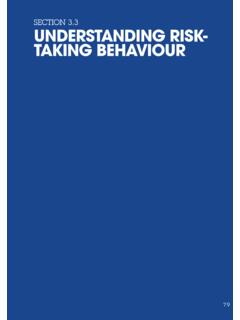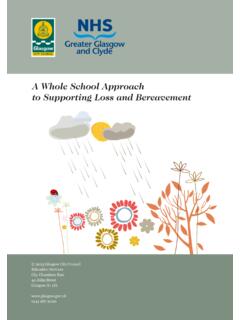Transcription of Guiding Children’s Behaviour - British Columbia
1 Guiding children s Behaviour 2 Table of Contents Introduction .. 3 Guiding children s Behaviour .. 3 A: Child Development Principles .. 4 B: Environment .. 5 C. Guidance Strategies Prevention .. 6 Intervention .. 9 D. Challenging behaviours .. 12 Summary .. 13 A Quick Guide .. 14 Originally developed in collaboration with the BC Day Care Action Coalition and the Early Childhood Educators of 1996. Revised 2003/02/25, 2016/11/4 3 Introduction children need adults to teach, guide, and support them as they grow and learn. Child care providers play an important role in Guiding children 's behavior in positive, supportive, and age-appropriate ways. The most appropriate ways to guide behavior may differ from child to child and will depend on the child s age and developmental abilities and needs.
2 Positive and supportive guidance helps children as they learn self-regulation and find appropriate ways to express their wants, needs, views and feelings. Guiding children s Behaviour is an ongoing process. This booklet provides recommended practices for Behaviour guidance; prevention and intervention strategies and techniques that are based on age-appropriate child development. This booklet also supports the Child Care Licensing Regulation requirement for licensed child care facility s to have a written behavioral guidance policy. Guiding children s Behaviour Guidance provides children with appropriate and positive models of Behaviour and helps them to develop respect, self-regulation, self-confidence and sensitivity as they learn and grow. Guidance is needed while appropriate Behaviour is happening, as well as before, during, and after inappropriate Behaviour is displayed.
3 Emotional and behavioural self-regulation contributes to young children s growing independence. It is this growing ability to control their own feelings and Behaviour that eventually allows a child to become more skilled in their relationships with children and adults, for example, when playing together or making decisions together. In the preschool years, children s self-regulation skills are still developing and can often go up and down. Being able to consistently regulate their own feelings and Behaviour is a major task for a young child. By school age, children become more flexible and are better at regulating their own emotions and actions. When children learn to self-regulate they have stronger friendships and relationships, are more able to pay attention and learn new things and deal with the normal stresses and disappointments of daily life.
4 I 4 A: Child Development Principles children s Behaviour is influenced by their age and level of development, their environment, and the adults who care for them. Caregivers need to understand that children experiment and make mistakes as a normal and expected part of their development. It is important to have reasonable expectations that are consistent with each child s age, developmental stage and abilities. Caregivers need to take time to offer developmentally appropriate guidance and explanations to help children gain confidence, competence, and problem-solving skills. Caregivers can be more effective in Guiding Behaviour and supporting children when they have an understanding of the different developmental stages and abilities of children they care for. children s experience in their family and culture influences their Behaviour .
5 Knowledge about a child s family and cultural background as well as respect for different value systems will help caregivers respond sensitively to the varying approaches to raising and caring for children . Caregivers who understand and appreciate principles of child development and family and cultural influences will develop attitudes and practices which are based on realistic expectations of children s Behaviour . 5 B: Environment Caregivers who are knowledgeable about the ways that social and physical environments affect Behaviour can plan their settings accordingly. Space The way in which space is used can either encourage or discourage appropriate Behaviour . It is important that enough space is available for children to play and learn in a relaxed setting. Minimize conflict by providing areas that are designated for adults or children , and/or individuals or groups.
6 Space that is pleasant to the eye, well-planned, organized and safe contributes to a positive environment and decreases the potential for problems. Things Toys and materials that are in good supply, and are age and developmentally appropriate, encourage children to focus and become involved in productive learning experiences. With groups of infants and toddlers, providing duplicates of favorite toys is important, as young children have not yet learned how to share and having duplicates with reduce avoidable conflicts. People children learn to interact with each other by seeing what the adults around them do. Adults need to create an environment that promotes trust, security, and comfort for the child. An adult s verbal and physical communication skills are critical in modelling the positive Behaviour they wish children to learn. Time / Program Schedule Schedules, routines, and enough time for changes/transitions are important for children and help children gain trust, security, and order.
7 While these can be flexible, caregivers need to provide children with information about what is expected. children need a balanced day of active and rest periods, individual and group activities, as well as adult initiated play. 6 C. Guidance Strategies Prevention Set Clear, Consistent, & Simple Limits Limits are statements of what Behaviour is appropriate. Limits ensure children know what is expected. Limits should be few in number, consistently enforced, and within the child s ability to understand. For example: Give Easy to Understand Explanations for Limits When children understand the reasons for limits, they are more likely to follow them. Teaching children the why of a limit helps them internalize and learn the rules. For example: Say Limits in a Positive Way, Rather Than in a Negative Way When adults focus on what to do, rather than what not to do, they reinforce what is appropriate, are models for children to copy, and decrease the likelihood for children to respond with defensiveness or resistance.
8 For example: Focus on the Behaviour , Rather Than on the Child Focus on a child s Behaviour . Give positive guidance for learning. Some messages can be seen as attacking or critical of a child s character and may produce feelings of guilt and shame and lower self-esteem. For example: o When you grab the truck, it makes Sam angry. Rather than: You re so rude. o It s not safe to climb on tables. Rather than: You naughty boy, get off the table. o Inside we walk. o Hands must be washed before we eat. o Sand stays down low so it doesn t get in people s eyes. o When you put the toys back on the shelf, others can find them. o It s time to put the blocks away. Rather than: Don t leave the blocks on the floor. o Turn the pages gently. Rather than: Don t be rough with the book. 7 Say What is Expected, Rather Than Ask It is important to state, rather than to ask when establishing limits or expected behaviours .
9 Asking questions implies that the child has a choice, when there may not be a choice. For example: Provide Choices Providing choices for young children can often help to avoid power struggles. Choices should only be offered when they are appropriate. For example: o Do you want to put your pants on first, or your shirt? Rather than: Get dressed now. o Do you want to have carrots or cucumbers with your sandwich? Rather than: You need to eat more vegetables. Give children Enough Time to Respond to Expectations children respond better when they know what is going to happen. children need cues and warnings ahead of time to help them to prepare for change . Adults should give children time to respond instead of demanding immediate action or results. For example: o In five minutes, it will be time to clean up. Rather than: Get that cleaned up now. o When everyone is sitting quietly, then I will begin the story.
10 Rather than: If you don t sit down there won t be a story. Ignore Minor Incidents Adults who work with young children need to develop tolerance for a certain amount of noise, clutter, and attention-seeking Behaviour . As long as children s activities are safe, not harming others or the environment, it is often best to take a breath, rather than to speak. o It s time to clean up now. Rather than: Do you want to help clean up? o o Your mommy is here. It s time to go home. Rather than: Do you want to go home now? 8 Reinforce Appropriate Behaviour , With Both Words and Gestures When children are behaving appropriately, it is important to acknowledge this through words or gestures. Positive reinforcement helps children build self-confidence and encourages them to repeat appropriate behaviours . Adults need to focus on the specific Behaviour , rather than on the character of the child.
